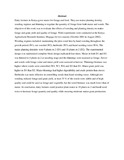The Impact Of Planting Density And Weeding Regimes On Maize As A Food And Fodder Crop

View/
Date
2011Author
Kivuva, B.M.
M.W. K, Mburu
Maina, J. M.
Murdoch, A. J .
Type
PresentationLanguage
enMetadata
Show full item recordAbstract
Dairy farmers in Kenya grow maize for forage and food. They use maize planting density,
weeding regimes and thinning to regulate the quantity of forage from both maize and weeds. The
objective of this work was to evaluate the effects of weeding and planting density on maize
forage and grain yield and quality of forage. Field experiments were conducted at the Kenya
Agricultural Research Institute, Muguga for two seasons (October 2001 to August 2002).
Weeding regimes included: maintaining the plots weed free by hand weeding throughout the
growth period (W1), not weeded (W2), herbicide (W3) and hand weeding twice (W4). The
maize planting densities were 9 plants m-2 (D1) and 18 plants m-2 (D2). The experimental design
was randomized complete block design replicated four times. Maize in both D1 and D2 was
thinned to 4 plants m-2 at tasseling stage and the thinnings were assessed as forage. Stover and
weeds with forage value and maize yield were assessed at harvest. Thinnings biomass was higher
where weeds were controlled (W1, W3, W4) and D2 than D1. Maize grain yield was higher in
D1 than D2. Maize thinnings had higher digestibility and crude protein than stover. Herbicide
was more effective in controlling weeds than hand weeding twice. Although not weeding
reduced forage and grain yield, at least 55 % of the weeds were edible and of high quality and
could be used as forage and vegetable, but the weed biomass was much lower than of maize. In
conclusion, dairy farmers could practice plant maize at 18 plants m-2 and hand weed twice to
increase forage quantity and quality while ensuring moderate maize grain production.
